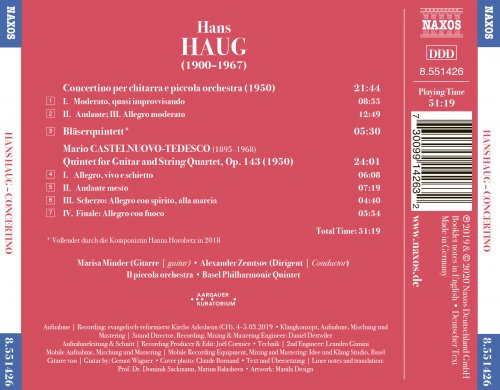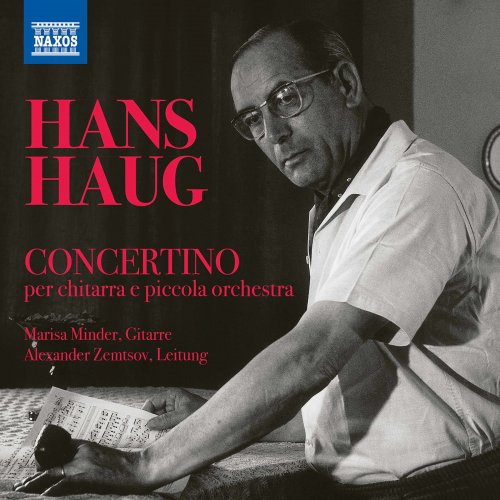
Il piccola orchestra, Basel Philharmonic Quintet - Hans Haug & Mario Castelnuovo-Tedesco: Chamber Works (2020)
BAND/ARTIST: Marisa Minder, Dmitry Smirnov, Yaryna Tyno, Eléonore Willi, Alexander Zemtsov, Il piccola orchestra, Basel Philharmonic Quintet
- Title: Hans Haug & Mario Castelnuovo-Tedesco: Chamber Works
- Year Of Release: 2020
- Label: Naxos
- Genre: Classical
- Quality: flac lossless
- Total Time: 00:52:15
- Total Size: 191 mb
- WebSite: Album Preview

Tracklist
01. Concertino for Guitar & Chamber Orchestra: I. Moderato, quasi improvvisando
02. Concertino for Guitar & Chamber Orchestra: II. Andante-III. Allegro moderato
03. Wind Quintet (Completed by H. Horobetz)
04. Quintet for Guitar & String Quartet, Op. 143: I. Allegro, vivo e schietto
05. Quintet for Guitar & String Quartet, Op. 143: II. Andante mesto
06. Quintet for Guitar & String Quartet, Op. 143: III. Scherzo. Allegro con spirito
07. Quintet for Guitar & String Quartet, Op. 143: IV. Finale. Allegro con fuoco
Hans Haug was born in Basel on July 27, 1900. He studied piano and violoncello at the Basel Conservatory and completed his musical education in Berlin with Ferruccio Busoni, and in Munich with Walter Courvoisier and Josef Pembaur. From 1924, he worked as a conductor in Solothurn, and in 1928 moved on to be employed by the Basel Theatre. During that time, premieres of his operas and operettas took place. In the following years of the Second World War a soldiers’ play Gilberte de Courgenay made him widely popular throughout the country.
In 1935 Haug headed the Orchestre de la Suisse Romande, and at a later stage took charge of Radioorchester in Zurich. In 1942 he finally settled in the French part of Switzerland, where he headed the Choeur de Lausanne. He visited Italy, France and Germany on his numerous tours. Hans Haug died in Lausanne on September 15, 1967.
In 1950 Haug’s Concertino per chitarra e piccola orchestra was awarded a prize in a competition for composers held by Accademia Chigiana in Siena. The author was promised that the brilliant Spanish guitarist Andrés Segovia would premiere it in 1952, and that his work would later be printed. However, Segovia did not play the work, which delayed its being printed until 1970, that is after Haug’s death. The Concertino was performed for the first time by soloist Alexandre Lagoya in Lausanne.
The name of the work "Concertino" provokes two key questions: how did the composer understand the genre name, and how did he shape the relationship between the guitar and a reduced orchestra? It includes only one flute, an oboe, two clarinets, a bassoon, a trumpet and a horn, timpani and strings - these would yet suffice to obscure the guitar as a solo instrument. Haug chose constellations of instruments to form two ensembles that accompany each other: the strings with their sustained sounds and the guitar with its percussive interventions. The plucked instrument plays in duo with a wind instrument every now and then. But even more determining are the layers of opposing rhythms and meters or the antagonism of scales, chords and short empty phrases within the ensemble itself.
Differing in their tempo, sections promptly alternate in the first part. An Andante and a brisk and lively Allegro moderato play the central part, while in the rear framing part the solo cadenza of the guitar slides in. The slow middle part lives on the contrast between a closed three-part lead theme and almost marching interventions, even more intertwining towards the end. The frolicsome Finale is a combination of forms of Rondo and Sonata, with an improvised Lentamente piece instead of the re-considered middle part, but all with an engrossing and rich in the solo cadenza oriented to the main theme of the part at the end. The swing delivered by this part is additionally accented by the opposition of three- and four-stress rhythms.
Similar distinctive features can be found in Bläserquintett; the layers of voices in it are even more balanced than in Concertino. The abstract contains remarkable combinations of different melodies, and the dualism of the tempos is especially challenging in terms of processing and performing.
Mario Castelnuovo-Tedesco (1895–1968) first met guitarist Andrés Segovia in 1932 and subsequently composed numerous pieces of music for guitar for him. Jewish Castelnuovo had to immigrate to America from Italy in 1939. There, he composed more than two hundred pieces of film music. Of his abundant creative legacy, the works inspired by his friendship with Segovia are still particularly well remembered; one example is Quintet for Guitar and String Quartet Op. 143 he composed in 1950 - the same year Haug created his Concertino.
The rhythmic aspect and the layers of tight motifs are decisive for the effect of Castelnuovo-Tedesco’s Quintet. The art and skill of Castelnuovo-Tedesco’s orchestration is distinguished by how the strings and the guitar meet as equals. Despite the positioning of the guitar as the solo, they both assume particular traits of the other instrument type without renouncing themselves or dominating each other. Such transparency is supported by smallscale sections formation, keeping single groups of measures and phrases clearly separated from each other within all four parts.
Year 2020 | Classical | FLAC / APE
As a ISRA.CLOUD's PREMIUM member you will have the following benefits:
- Unlimited high speed downloads
- Download directly without waiting time
- Unlimited parallel downloads
- Support for download accelerators
- No advertising
- Resume broken downloads


